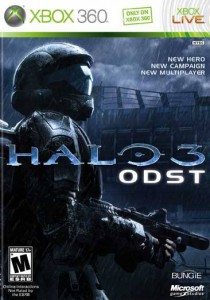$20 Game of the Week: Halo 3 ODST (Xbox 360)
by William Talley, filed in $20 Game Of The Week on Feb.06, 2011
 The fight may have been finished back in 2007 with Halo 3, but thankfully there are still plenty of stories to tell about the Halo universe. One of them is the tale of a group of Orbital Drop Squad Troopers (or Helljumpers as they are nicknamed, and for good reason) and the losing battle they fought in the ill-fated African city of New Mombasa in the period between Halo 2 and Halo 3. You take control of one of these soldiers as you explore the city in an attempt to find out what’s going on. Originally conceived as a downloadable add-on (and originally slated to be called Halo 3: Recon), so much work was put into the story, setting, and characters, that Bungie ended up releasing the game as a standalone 2-disc package available at full retail price. The first disc contains the campaign (which can be played with up to 4 players) and a new mode called firefight where you fight off waves of covenant soldiers similar to Gears of War 2’s Horde mode. The second disc contains every map released for Halo 3, including those released on the Xbox Live Marketplace. The game also includes the Forge map editor for creating your own worlds.
The fight may have been finished back in 2007 with Halo 3, but thankfully there are still plenty of stories to tell about the Halo universe. One of them is the tale of a group of Orbital Drop Squad Troopers (or Helljumpers as they are nicknamed, and for good reason) and the losing battle they fought in the ill-fated African city of New Mombasa in the period between Halo 2 and Halo 3. You take control of one of these soldiers as you explore the city in an attempt to find out what’s going on. Originally conceived as a downloadable add-on (and originally slated to be called Halo 3: Recon), so much work was put into the story, setting, and characters, that Bungie ended up releasing the game as a standalone 2-disc package available at full retail price. The first disc contains the campaign (which can be played with up to 4 players) and a new mode called firefight where you fight off waves of covenant soldiers similar to Gears of War 2’s Horde mode. The second disc contains every map released for Halo 3, including those released on the Xbox Live Marketplace. The game also includes the Forge map editor for creating your own worlds.
ODST is a departure from other Halo games. Instead of the mighty Master Chief, you step in the shoes of “The Rookie”. You and your squad land on New Mombasa, but after departure, things go wrong almost immediately. You come around 6 hours after landing. It’s twilight, Covenant soldiers are mopping up any stragglers, and your squad is nowhere to be found. It’s up to you to piece together clues as to what happened, while still trying to find a way to keep in the fight. Throughout the game, you’ll find bits and pieces alluding to what happened. As you find these clues, you’ll learn about the exploits of your squad in playable flashback sequences.
There are a few departures in the gameplay. For one, your health doesn’t automatically replenish (seeing as how you’re not a badass spartan and all), so you’ll have to seek out, and make the most of, the health packs scattered about. Also, you can forget about dual wielding. There is a map feature, and it makes it easy to figure out how to get where you’re going. You’re aided by an A.I. known as the superintendent, who is basically Halo’s answer to CP30. The game’s score made me pay attention to Halo’s music, something I’ve never done before. The soundtrack does a great job of drawing you into what’s going on, weather I’m exploring a desolate nighttime cityscape or in the middle of a heated firefight. The past 3 Halo games, which I enjoyed mind you, didn’t even accomplish this. The game’s atmosphere and music evokes a mood of despair and desperation. However, without spoiling anything, there is a happy ending waiting if you press forward.
Whether the initial $60 price tag was justified is debatable, but if you’re a fan of Halo, then this is yet another worthy addition to the series. It also did a good job of keeping players tied over until Reach arrived.


 PS3
PS3
 Famicom Dojo
Famicom Dojo KEEP PLAYING
KEEP PLAYING KEEP PLAYING: Rewind
KEEP PLAYING: Rewind Powet Toys
Powet Toys Powetcast
Powetcast Hitchhiker's Guide POWETcast
Hitchhiker's Guide POWETcast















